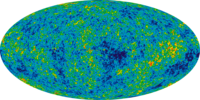
Photo from wikipedia
The standard model of cosmology with nearly Gaussian, isotropic, scale invariant and adiabatic initial conditions describes the cosmological observations well. However, the study of any deviation from the mentioned conditions… Click to show full abstract
The standard model of cosmology with nearly Gaussian, isotropic, scale invariant and adiabatic initial conditions describes the cosmological observations well. However, the study of any deviation from the mentioned conditions will open up a new horizon to the physics of early universe. In this work, we study the effect of the oscillatory and step-like features in potentials of inflationary models in late time large scale structure observations. Mainly we study the matter power spectrum, number density of the structures, dark matter halo bias and specifically CMB lensing. We show that the oscillatory models can introduce some degeneracy with late time effects on BAO scale. We also conclude that high frequency oscillatory models which are favored by Planck data do not have significant effect on the non linear structure formation. Finally we show that inflationary models with step functions which deviates from the standard model in small scales $l \leq 1 Mpc$ can be constrained by future experiments via CMB lensing. We propose the idea that CMB lensing is a bias independent observation which can be used as a small scale physics probe due to distribution of the lenses in low redshifts. Meantime this model can alter the prediction of the cosmological model for the number density of small structures and can be used as a probable explanation for galactic scale crisis of $\Lambda$CDM.
Journal Title: Journal of Cosmology and Astroparticle Physics
Year Published: 2018
Link to full text (if available)
Share on Social Media: Sign Up to like & get
recommendations!